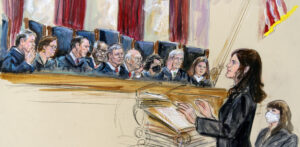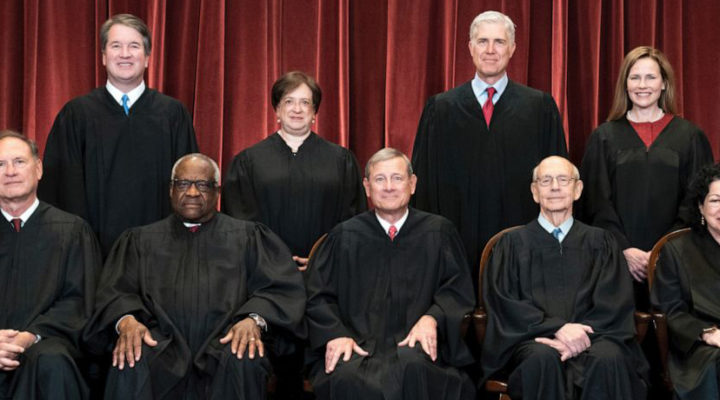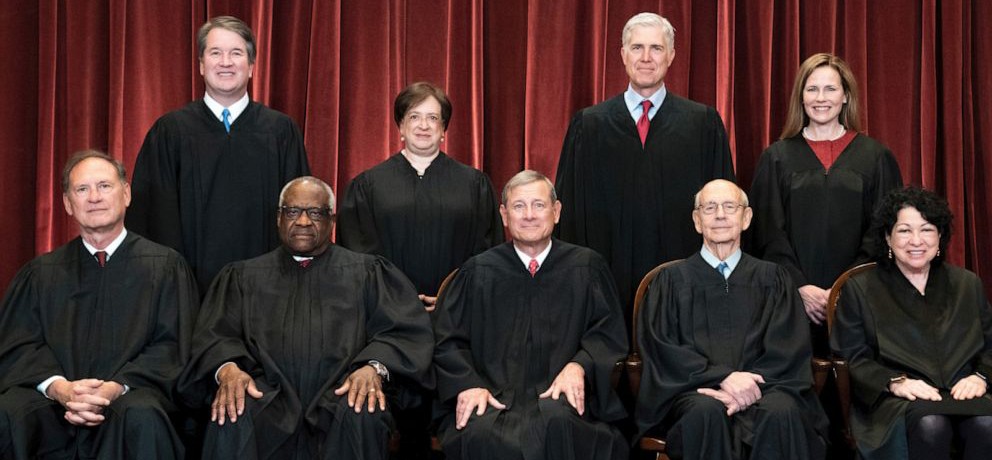To kick things off today, just a quick reaction to last Wednesday’s Jan. 6 House committee hearings, which featured Cassidy Hutchinson, an aide to former White House chief of staff Mark Meadows. Her testimony contained startling new revelations, even in light of what we already had learned about former President Trump’s character and personal conduct over the last five years. We learned the favored president of the white Christian right:
- Declared that Mike Pence, his own vice president, deserved to be hung for fulfilling his constitutional duty.
- Assaulted the head of his presidential Secret Service detail for trying to keep him safe and away from the U.S. Capitol building during the riot.
- Attempted to have the magnetometers disabled before his speech on Jan. 6 so the crowds supporting him could bring in weapons. (Hutchinson testified that she overhead Trump saying, “I don’t F-ing care that they have weapons. They’re not here to hurt me.”)
- Regularly threw dishes against the wall and overturned tables in the White House dining room when he received news he disliked from his senior staff.
Court attacks three standards
These revelations are disturbing, if not surprising. But what I want to focus on today is the conservative supermajority on this U.S. Supreme Court, half of whom were appointed by the former president described above.
In just the last week, the Supreme Court has attacked three standards that have stood for nearly half a century. It has taken a hammer to the wall of separation between church and state, allowed a Southern state to weaken the voting power of African Americans, and called into question the right to privacy that secured a right to legal abortion (as well as same-sex marriage, access to contraception, and potentially even interracial marriage).
“This court is systematically erecting a new judicial standard based on an invocation of ‘history and tradition’ that is rooted in a vision of a mythical 1950s white Christian America.”
As troubling as these decisions are, there is an even more dangerous common thread connecting them. This court is systematically erecting a new judicial standard based on an invocation of “history and tradition” that is rooted in a vision of a mythical 1950s white Christian America.
A case that ‘begins with a lie’
First, in Kennedy v. Bremerton School District, a 6-3 conservative majority voted to side with a public school football coach who held Christian prayers on the field immediately after games. As RNS’s Mark Silk notes, the majority opinion in this case “begins with a lie,” claiming that “petitioner Joseph Kennedy lost his job as a high school football coach in the Bremerton School District after he knelt at midfield after games to offer a quiet personal prayer.”

In this photo provided by the Bremerton school district, Joseph Kennedy is seen leading his “quiet prayer by himself” at midfield.
Legal arguments aside, Kennedy’s prayer was neither quiet nor personal. One look at a photograph of the events in question clearly shows a public school football coach (a government employee) leading a very public prayer on the 50-yard line of the football field (a government-owned facility) while fans are still in the stands and while he and the players are still in their public school provided uniforms.
The disingenuousness of the conservative justices’ description of the facts of the case is bad enough. But the majority had a larger agenda. It took the opportunity to run roughshod over the “Lemon test,” a legal test that has guarded church-state separation since 1971.
This longstanding guide held that any government conduct must meet three criteria: 1) It must have a clear secular purpose; 2) It must not have the primary effect of advancing or inhibiting religion; and 3) It must not create an excessive governmental entanglement with religion. In addition to the Lemon test, it also ignored Reagan appointee Sandra Day O’Connor’s 1984 endorsement test that proposed a standard of whether “a reasonable, informed observer” would perceive an act as a government endorsement of religion.
Instead, the conservative majority on the court replaced those previous legal tests with the ambiguous idea that Establishment Clause cases “must be interpreted by ‘reference to historical practices and understandings.’” If public prayers at public schools have long historical precedents, the new logic goes, they deserve less scrutiny.
“If the Christian Coach Kennedy had been Hindu Coach Patel, it is highly unlikely that this case would have been filed or even granted certiorari by this court.”
If this new test takes hold, it (by design) will unravel 50 years of church-state jurisprudence at both the federal and state levels. By pegging Establishment Clause logic to “historical practices and understandings,” the court not only allows excessive entanglement of government and religion, but — because the dominant religion in the U.S. has historically been Christianity—it simultaneously privileges Christianity over other religions. If the Christian Coach Kennedy had been Hindu Coach Patel, it is highly unlikely that this case would have been filed or even granted certiorari by this court.
Ultimately, the new standard doesn’t protect religious liberty; it privileges Christian religious expressions over others.
Racial bias in voter maps allowed
Second, the conservative majority on the Supreme Court also allowed a Congressional redistricting map drawn by Louisiana Republicans to remain in place. They took no action on Ardoin v. Robinson, even with the midterm elections on the horizon, and despite a lower court’s determination that the Republican scheme likely violated the Voting Rights Act of 1965 because it seems to be designed specifically to dilute the voting power of African Americans.
The Black population of Louisiana is 33%, but the new map pushed most African Americans into only one of six districts, essentially reducing their relative representation by half.
This past February, the court allowed a similar map drawn by Alabama Republicans to stand. The court has indicated it will revisit these cases in October — after these racist and partisan redistricting schemes govern the outcomes of the 2022 midterm elections.
Undermining the right to privacy
Finally, the same 6-3 majority conservative majority voted not just to uphold a Mississippi law that bans virtually all abortions after the 15th week of pregnancy (and has no exceptions for rape or incest), not just to overturn Roe v. Wade, but also to undermine the very idea that a right to privacy exists in the Constitution.
A piece I wrote just after the leaked Supreme Court opinion in early May has become the most-read White Too Long newsletter of all time.
When I published that column, I received pushback about my concerns that this broadside attack on a right to privacy would put protections for same-sex marriage, access to contraception, and even potentially interracial marriage at risk. But Justice Thomas, in his concurring opinion, explicitly put each of these rights (with the notable exception of interracial marriage) in the crosshairs, arguing that the court should reconsider these landmark cases and “correct the error” they represent in his view.
“I’m also struck by the blatant dishonesty of the recently appointed conservative justices.”
I’m also struck by the blatant dishonesty of the recently appointed conservative justices. Each of them was asked about their stance on Roe and whether they understood it as standing precedent and settled law. Each equivocated, and none had the integrity to declare their clear opposition, which is now laid bare in this ruling. Here’s Justice Alito’s flat condemnation of Roe from the recent decision:

This artist sketch depicts Center for Reproductive Rights Litigation Director Julie Rikelman speaking to the Supreme Court, Wednesday, Dec. 1, 2021, in Washington. Seated to Rikelman’s right is Solicitor General Elizabeth Prelogar. Justices seated from left are Associate Justice Brett Kavanaugh, Associate Justice Elena Kagan, Associate Justice Samuel Alito, Associate Justice Clarence Thomas, Chief Justice John Roberts, Associate Justice Stephen Breyer, Associate Justice Sonia Sotomayor, Associate Justice Neil Gorsuch and Associate Justice Amy Coney Barrett. (Dana Verkouteren via AP)
Stare decisis, the doctrine on which Casey’s controlling opinion was based, does not compel unending adherence to Roe’s abuse of judicial authority. Roe was egregiously wrong from the start. Its reasoning was exceptionally weak, and the decision has had damaging consequences.
Had Alito and the other conservative justices had the courage of their convictions at their confirmation hearings, at least some Republican Senators like Susan Collins — and the six in 10 Americans who oppose overturning Roe — would have thought twice about handing them lifetime appointments to the nation’s highest court.
A troubling theme
Beyond the substance of these three rulings, I’m deeply troubled by an underlying theme that has received less attention. There is a peculiar and slippery invocation of history and tradition by the conservative justices, which is doing some heavy conceptual lifting. I’ve already cited the reference to “historical practices and understandings” in the Bremerton case. Here’s a similar reference to “the history and tradition” from the Dobbs case:
Guided by the history and tradition that map the essential components of the Nation’s concept of ordered liberty, the Court finds the Fourteenth Amendment clearly does not protect the right to an abortion. Until the latter part of the 20th century, there was no support in American law for a constitutional right to obtain an abortion.
This concept of “history and tradition” is, at best, an unreliable arbiter of Constitutional rights. It begs at least two thorny questions: “Whose history?” and “Which traditions?” The answer to these questions gives content to the concept of “the nation” evoked here.
History is what we see when we look over our shoulder, always necessarily standing in a particular place. It consists of the stories we tell ourselves in order to understand who we are. And like all stories, the beginnings are important. The “once upon a time” sets the stage and determines what counts as the “happily ever after.” (This is why the recent battles between 1619 vs. 1776 have been so intense.)
In the Dobbs case, the conservative majority of the court tells us, fairly explicitly, where they see the anchor of the nation’s history: somewhere before “the latter part of the 20th century.” This vantage point determines the stories (history) and the practices (tradition) that count as normative and warrant the protection of the law.
Headed back to the 1950s
We have fairly strong evidence from public opinion data indicating more precisely where political conservatives today believe this historical marker should be placed. The conservative justices, all appointed by Republican presidents, are giving expression — and legal power — to views that are widely shared by rank-and-file Republicans. In PRRI’s 2021 American Values Survey, 70% of Republicans believed that “American culture and way of life has changed for the worse since the 1950s,” a view shared by only 52% of independents and 36% of Democrats.
“This invention of 1950s America as a legal fulcrum in the highest court in the land should send a chill up our spines.”
This invention of 1950s America as a legal fulcrum in the highest court in the land should send a chill up our spines. This version of “history and tradition” evokes a falsely idyllic vision of white Christian America, a land that mythically existed before the troubles of racial integration and equal rights for non-white Americas, women’s liberation, LGBTQ equality, the exodus of young people from traditional religious congregations, and dramatic demographic change.
Throughout the Trump years, the phrase “saying the quiet part out loud” has captured the disbelief of many Americans at the normalization of all sorts of bigotry by political leaders. The conservative majority of the U.S. Supreme Court has just explicitly told us, in published decisions, that their ideal vantage point for evaluating the history and traditions of the United States is 1950s America, and that this perspective will replace long-established legal tests and guidelines based on legal principles.
More to come
This new legal weapon is likely to proliferate. On Monday, the first business day after the Dobbs ruling, an appeal filed in Alabama picked up this logic, arguing that the state has the authority to outlaw therapies for transgender minors because they are not “deeply rooted in our history or traditions.”
Both the MAGA-driven attacks on the U.S. Capitol that were encouraged by Trump and the radical actions of this Supreme Court are reminders that the unfolding agenda is a nostalgia-fueled gambit to drag the country back to the 1950s, particularly with regard to issues related to religion, race, and gender identity and sexual orientation. We are seeing in real-time naked attempts to restore the old hierarchies of Christians over non-Christians, white over non-white, and straight cisgender men over all others. This vision is not driven by a commitment to the Constitution and democracy but by an imposition of a vision of the country as a divinely ordained promised land for European Christians.
“This vision is not driven by a commitment to the Constitution and democracy but by an imposition of a vision of the country as a divinely ordained promised land for European Christians.”
We must see these developments for what they are: expressions of raw political power by a desperate white Christian minority whose belief in its own divine righteousness has unmoored it from its democratic commitments. And we must grasp the danger they represent for everyone else.
I’ll close with this final thought. As most of you know, I’m from Mississippi. I can’t help but read these discussions through the lens of my home state’s history. We know what a euphemism like “history and tradition” means. And we know where it will lead.

Robert P. Jones (Photo by Noah Willman)
Robert P. Jones is CEO and founder of PRRI and the author of White Too Long: The Legacy of White Supremacy in American Christianity, which won a 2021 American Book Award.
This column originally appeared on Robert P. Jones’s substack #WhiteTooLong.
Related articles:
Alito and public opinion reveal the link between Roe and a broader white Christian nationalist agenda | Opinion by Robert P. Jones


